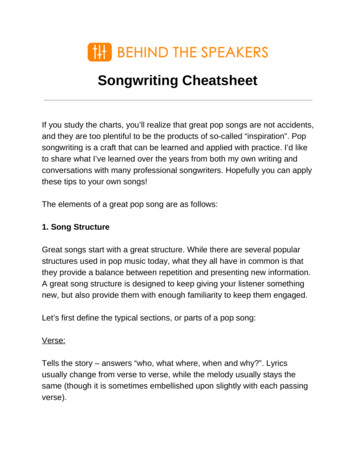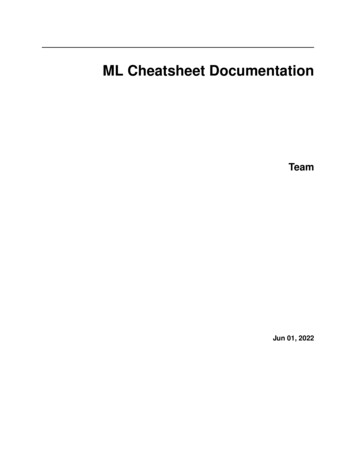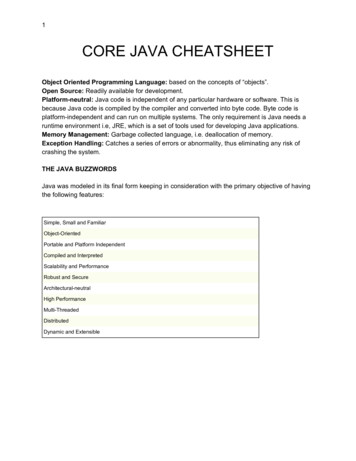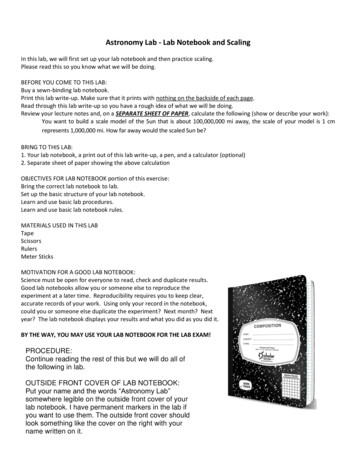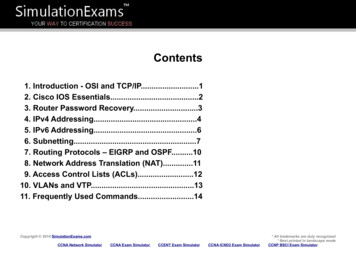
Transcription
Contents1. Introduction - OSI and TCP/IP.12. Cisco IOS Essentials.23. Router Password Recovery.34. IPv4 Addressing.45. IPv6 Addressing.66. Subnetting.77. Routing Protocols – EIGRP and OSPF.108. Network Address Translation (NAT).119. Access Control Lists (ACLs).1210. VLANs and VTP.1311. Frequently Used Commands.14Copyright 2014 SimulationExams.comCCNA Network SimulatorCCNA Exam SimulatorCCENT Exam SimulatorCCNA ICND2 Exam Simulator* All trademarks are duly recognized* Best printed in landscape modeCCNP BSCI Exam Simulator
Cisco CCENT : OSI and TCP/IPOSI MODELApplication : Responsible for identifying and establishing the availability of desiredcomm partner and verifying sufficient resources exist for comm. Ex: FTP, SMTPTCP/IP MODELPresentation : Responsible for presenting the data in standard formats. SomePresentation layer standards are JPEG, MPEG, MIDI, PICT, Quick Time, TIFF.Application : Defines TCP/IP application protocols and howhost programs interface with transport layer services to usethe network. Ex: FTP, SMTP, TelnetSession : Responsible for co-ordinating communication between systems/nodes.Some of the session layer protocols and interfaces: NFS, RPC, SQL, ASP, DNA SCPTransport : Provides communication session management betweenhost computers. Ex: TCP, UDPTransport : Responsible for multiplexing upper-layer applications, session mgmttearing down of virtual circuits, flow control and to maintain data integrity.Internet : Performs routing of IP datagrams.Network : Responsible for sending packets from the source network to the destinationnetwork using routing methods. Routers work at network layer.Ex: IP, ARP, ICMPDatalink : Consists of LLC sublayer and MAC sublayer. LLC handles error control, flowflow control, framing etc. MAC handles access to shared media such as ethernet.Physical : Controls the hardware devices and media that makeup the network.Physical : Responsible for ultimate transmission of data over network communicationsmedia. Some of the standard interfaces at physical layer are EIA/TIA-232, V.24,V.35, HSSIPort numbers used by TCP/UDP0-255 : Used for public applications255-1023 : Assigned to companiesAbove 1023 : Used by upper layers to set up sessions with other hosts and byTCP to use as source and destination addresses.Some important port numbersFTP : Port 20-21TFTP : Port 69Telnet : Port 23SMTP : Port 25DHCP : Ports 67 and 68DNS : Port 53POP3 : Port 110HTTP : Port 80Copyright 2014 SimulationExams.comCCNA Network SimulatorCCNA Exam SimulatorCCENT Exam SimulatorCCNA ICND2 Exam Simulator1* All trademarks are duly recognized* Best printed in landscape modeCCNP BSCI Exam Simulator
Cisco CCENT : IOSRouter Cursor CommandsInternal memory components of a cisco router ctrl A: Move to the beginning of the command line ctrl E: Move to the end of the command line ctrl F: Move forward one character, same as using “Right Arrow” ctrl B: Move backward one character, same as using “Left Arrow". ctrl P: Repeat Previous command, same as using “Up Arrow” ctrl N: Repeat Next (more recent) command, same as using "Down Arrow" esc B: Moves to beginning of previous word. esc F: Moves to beginning of next word. ctrl R: Creates new command prompt, followed by all thecharacters typed at the last one.ROM : Memory containing micro-code for basic functions to start and maintain the router.RAM/DRAM : Stores the running configuration, routing tables, and packet buffers.NVRAM : Memory that does not lose information when power is lost. Stores the system’sconfiguration file and the configuration register.Flash Memory : Stores the compressed IOS image.Router Default Boot Sequence for Cisco IOSRouter boot configuration commands1. NVRAM2. Flash (sequential)boot system ROM : boots from system ROMboot system flash IOS file name : bootsIOS from flash memoryboot system tftp IOS file name tftp addr : boots IOS from a tftp server3. TFTP server4. ROMThe router first looks at Startup Config file in NVRAM, if not available, it falls back to Flash, thento TFTP and then to ROM.Configuration Register CommandRouter(config)# config-register 0x10x (where that last x is 0-F in hex), when the last x is: 0 bootinto ROM Monitor mode; 1 boot the ROM IOS; 2 - 15 look in startup-config file in NVRAM.Cisco router configurable locationsRouter modes of operation includeRouter passwordsMode--------------------------- Promptuser exec--------------------- Router Privileged---------------------- Router #global config------------------ Router(config)#Interface config-------------- Router(config-if)#Enable passwordConsole passwordEnable SecretVirtual terminal password (vty)Auxiliary passwordConsole port, Virtual Terminals (vty), Auxiliary port, TFTP server and Network management stationMore infoThree ways router learns to forward packets1. Static routes : Configured by the administrator manually. Syntax : ip route ip-addr mask-addr ip-addr Ex: R1(config)#ip route 192.168.200.0 255.255.255.0 192.168.1.22. Default routes : This is used when a route is not known or is infeasible. Syntax : ip route 0.0.0.0 0.0.0.0 ip-addr Ex: R1(config)#ip route 0.0.0.0 0.0.0.0 192.168.1.23. Dynamic routes : In dynamic routing, the routing tables are automatically updated.Dynamic routing uses broadcasts and multicasts to communicate with other routers.To enable the Cisco IOS to forward packets destined forobscure subnets of directly connected networks onto the bestroute, use "ip classless" command.By default, Cisco routers support 5 simultaneous telnet sessions.This number can be configured using IOS commands.Copyright 2014 SimulationExams.comCCNA Network SimulatorCCNA Exam SimulatorCCENT Exam SimulatorCCNA ICND2 Exam Simulator2* All trademarks are duly recognized* Best printed in landscape modeCCNP BSCI Exam Simulator
Cisco CCENT : Password RecoveryProcedure 1Procedure 2Complete these steps in order to recover your password:Complete these steps in order to recover your password:1. Shut down the router.2. Remove the compact flash that is at the back of the router.3. Power on the router.4. Once the Rommon1 prompt appears, enter this command:confreg 0x21425. Insert the compact flash.6. Type reset.7. When you are prompted to enter the initial configuration, type No, and press Enter.8. At the Router prompt, type enable.9. At the Router# prompt, enter the configure memory command, and press Enter inorder to copy the startup configuration to the running configuration.10. Use the config t command in order to enter global configuration mode.11. Use this command in order to create a new user name and password:router(config)#username cisco password cisco12. Use this command in order to change the boot statement:config-register 0x210213. Use this commnd in order to save the configuration:write memory1. Attach a terminal or PC with terminal emulation to the console port of the router andset terminal settings to 9600 baud rate, No parity, 8 data bits, 1 stop bit, No flowcontrol.The configuration register is usually set to 0x2102 or 0x102. If you can no longeraccess the router you can safely assume that your configuration register is set to0x2102.2. Use the power switch in order to turn off the router, and then turn the router back on.3. Press Break on the terminal keyboard within 60 seconds of power up in order to putthe router into ROMmon.4. Type confreg 0x2142 at the rommon 1 prompt in order to boot from Flash. This stepbypasses the startup configuration where the passwords are stored.5. Type reset at the rommon 2 prompt.The router reboots, but ignores the saved configuration.6. Type no after each setup question, or press Ctrl-C in order to skip the initial setupprocedure.7. Type enable at the Router prompt.You are in enable mode and should see the Router# prompt.8. Type configure memory or copy startup-config running-config in order to copythe nonvolatile RAM (NVRAM) into memory.9. Type configure terminal.The router(config)# prompt appears.10. Type enable secret password in order to change the enable secret password.For example:router(config)#enable secret cisco11. Issue the no shutdown command on every interface that you use.12. Type write memory or copy running-config startup-config in order to commit thechanges.Reload the router, and then use the new user name and password to log in to therouter.Note : The given procedures are generic in nature, and for exact sequence of steps, please refer to product manual.Copyright 2014 SimulationExams.comCCNA Network SimulatorCCNA Exam SimulatorCCENT Exam Simulator3CCNA ICND2 Exam Simulator* All trademarks are duly recognized* Best printed in landscape modeCCNP BSCI Exam Simulator
Cisco CCENT : IPv4 AddressingConverting Binary to DecimalConverting Decimal to BinaryBinary is a base 2 system with only two numbers 0 or 1.The weightage of binary digits from right most bit position to the left most bitposition is given below.Decimal is a Base 10 system with 10 possible values (0 to 9)To convert decimal to binary, simply divide the decimal value by 2 and then writedown the remainder, repeat this process until you cannot divide by 2 anymore.For example, take the decimal value 157:157 2 7839 2 199 2 42 2 1Example :with a remainder of 1with a remainder of 1with a remainder of 1with a remainder of 078 2 3919 2 94 2 21 2 0with a remainder of 0with a remainder of 1with a remainder of 0with a remainder of 1To convert, write this remainder first----------- Convert 10011101 into a decimal value.There are eight bits in the binary number. The decimal value for each bit positionis given below:Next write down the value of the remainders from bottom to top (in other wordswrite down the bottom remainder first and work your way up the list) whichgives:10011101 157To convert, you simply take a value from the top row wherever there is a 1 below,and then add the values together.i.e,1*27 0*26 0*25 1*24 1*23 1*22 0*21 1*20 128 0 0 16 8 4 0 1 157 (decimal value)Copyright 2014 SimulationExams.comCCNA Network SimulatorCCNA Exam SimulatorCCENT Exam Simulator4CCNA ICND2 Exam Simulator* All trademarks are duly recognized* Best printed in landscape modeCCNP BSCI Exam Simulator
Cisco CCENT : IPv4 AddressingIP Address IntroIP Address Classes ( Public IP range)1. An IP address (32 bit number, 4 bytes) consists of four octets seperatedby 16,384CN.N.N.H110192 -2232,097,152The octet is a binary number of eight digits, which equals the decimal numbersfrom 0 to ax-hosts16,777,21465,534254Class D addresses are used for multicasting, they begin with “1110” and the addr range is 224-239.Class E addresses are reserved addresses that begin with “11110” and the range is 240-254.2. The internet protocol defines the special network address 127.0.0.1 as alocal loopback address.IPV4 HeaderPrivate addr range : Class A : 10.0.0.0 to 10.255.255.255, Class B : 172.16.0.0 to 172.31.255.255,Class C : 192.168.0.0 to 192.168.255.255Subnet Mask and CIDR notationA Subnet mask is a 32-bit number that masks an IP address, and divides the IP address into networkaddress and host address.Subnet Mask is made by setting network bits to all "1"s and setting host bits to all "0"s.Default Subnet MasksClass A : 255.0.0.0, Class B : 255.255.0.0, Class C : 255.255.255.0CIDR Notation : Classless Inter Domain Routing (CIDR) is a method for assigning IP addresses withoutusing the standard IP address classes like Class A, Class B or Class C.In CIDR notation, an IP address is represented as A.B.C.D /n, where "/n" is called the IP prefix or networkprefix. The IP prefix identifies the number of significant bits used to identify a network.Ex: 216.3.128.12, with subnet mask of 255.255.255.128 may be written as 216.3.128.12/25 usingCIDR Notation.Copyright 2014 SimulationExams.comCCNA Network SimulatorCCNA Exam SimulatorCCENT Exam Simulator5CCNA ICND2 Exam Simulator* All trademarks are duly recognized* Best printed in landscape modeCCNP BSCI Exam Simulator
Cisco CCENT : IPv6 AddressingIPv6 : Points to RememberIPv6 Header1. IPv6 address is 128 bits in length represented in hexadecimal2. IPv6 Loopback address is 0:0:0:0:0:0:0:1, also expressed as ::1.3. IPv6 reserves two special addresses. They are 0:0:0:0:0:0:0:0 and 0:0:0:0:0:0:0:1.4. Three transition strategies for migration from ipv6 to ipv4 are dual stacking, 6-to-4 tunneling and NAT-PTIPv6 AddressingVersion (4 bits) : IP version number (6)IPv6 address consists of 8 groups of four hexadecimal digits separated by colons and which mainly consistsof 3 segments called Global Prefix which is of 48 bits, subnet part with 16 bits and Interface ID called as Hostpart with 64 bits.Traffic Class (8 bits) : Used for QoSThe first 3 octets constitute Global Prefix, the fourth octet constitute subnet part and the last four form theInterface ID.Payload Length (16 bits) : Length of the IPv6 payloadFlow Label (20 bits) : Used for packet labellingNext Header (8 bits) : Identifies the type of header following the IPv6 headerHop Limit (8 bits) : Number of hops until the packet gets discarded.Source Address (128 bits) : Source IP addressRules : a) One set of 0's in the address can be replaced by :: but this can be done only onceb) One or any number of consecutive groups of 0 value can be replaced with two colons (::)EUI-64 FormatDestination Address (128 bits) : Destination IP addressIPv6 Communication TypesMAC to EUI-64 conversion inserts hex “FFFE” in the middle of a MAC addr, Then flipsthe U/L bit to 1, in order to create a 64-bit interface ID from a 48-bit Mac address.Unicast : used for one-to-one communication.There are 3 types of unicast addresses namelyglobal, unique-local and link-localMulticast : used for one-to-many communicationIPv6 multicast address begins with "FF"Anycast : used for one-to-one-of-manycommunicationCopyright 2014 SimulationExams.comCCNA Network SimulatorCCNA Exam SimulatorCCENT Exam SimulatorCCNA ICND2 Exam Simulator6IPv6 Address Scopes::/0---------------- Default Route::/128------------ Unspecified::1/128----------- LoopbackFC00::/7--------- Unique Local UnicastFE80::/10-------- Link-Local UnicastFEC0::/10------- Site-Local UnicastFF00::/8---------- Multicast* All trademarks are duly recognized* Best printed in landscape modeCCNP BSCI Exam Simulator
Cisco CCENT : SubnettingRequirement for IPv4 SubnettingSubnetting Scenarios1. Efficient use of available IP address space2. Network traffic isolation3. Improved security4. Limiting broadcast messagesThe subnetting scenarios may broadly be divided in to two categories:1. Optimize for a given number of hosts2. Optimize for a given number of subnetsFinally, determine the host address range for each available subnet.Subnetting Scenario Question 1You want X number of subnets, what is the subnet mask ? (Assume we need 10 subnets, i.e, X 10)Tip : Convert X to binary, determine how many low order bits need to make the number, that many bits is number of high order bits that make up your subnet mask, convert high order bits todecimal value.Solution :Consider the Class C address – N.N.N.H where N is the Network portion and H is the host portion. Host Portion is as shown ----- Step 1: Convert 10 to binary. Binary equivalent of 10 is as shown --------- Step 2: Number of low order bits required to make the number is 4 (from the figure shown above)Step 3: Therefore 4 high-order bits make up the subnet mask, i.e, 128, 64, 32, 16Add 4 high order bits to create subnet mask i.e. 128 64 32 16 240 (11110000). The subnet mask is 255.255.255.255.240255.255.255.240 is represented as -------- Copyright 2014 SimulationExams.comCCNA Network SimulatorCCNA Exam SimulatorCCENT Exam Simulator7CCNA ICND2 Exam Simulator* All trademarks are duly recognized* Best printed in landscape modeCCNP BSCI Exam Simulator
Cisco CCENT : SubnettingSubnetting Scenario Question 3Determine the range of valid IP Addresses for an X subnet mask ? (Assume X value to be 240 in this case)Tip : Convert X to binary and determine the decimal value of lowest high order bit, start the range of addresses at that value, and increment the range by that value.Solution :Step 1: Convert 240 to binary. Binary equivalent of 240 is as shown --------- Step 2: The decimal value of lowest high order bit is 16 (24) as seen from the figure above. Therefore, this number becomes the increment value to determine the IP address ranges.Subnet Mask: 255.255.255.240Subnet Bits: 28Number of Subnets: 16Host Bits: 4Hosts per Subnet: 14The range of addresses for the given mask is as shown ------ Note: All zeros and all ones host addresses cannot be used.Copyright 2014 SimulationExams.comCCNA Network SimulatorCCNA Exam SimulatorCCENT Exam Simulator8CCNA ICND2 Exam Simulator* All trademarks are duly recognized* Best printed in landscape modeCCNP BSCI Exam Simulator
Cisco CCENT : SubnettingSubnetting Scenario Question 2How many subnet bits are required for X number of hosts ? (Assume X value to be 5 in this case)Tip : Convert X (for the subnets) to binary, determine the number of bits needed for the host portion, additionally determine the subnet mask from the remaining bits, using formula 2ⁿ, find therelevant number of subnets in this scenario.Solution :Step 1: Consider the Class C address N.N.N.H, where H is the host portion whose binary and decimal representation is as shown ---- Convert 5 to binary. Binary equivalent of 5 is as shown --------- Step 2: As shown in the figure above, the number of bits needed for the host portion are 3. Therefore,2bits-2 23-2 6 (6 5)3 bits are required for the host portion for 5 hosts.Step 3 (Additional): To know the subnet mask , add the decimal value of the remaining 5 bits i.e, (128 64 32 16 8) 248Subnet Mask is 255.255.255.248 (11111111.11111111.11111111.11111000)Number of subnet bits: 29, here 5 bits are used from the host portion of our subnet maskTherefore number of subnets required is (2n), where 'n' is the number of bits being used from the host portion of our subnet mask i.e. 5Therefore, 25 32 is the number of subnetsCopyright 2014 SimulationExams.comCCNA Network SimulatorCCNA Exam SimulatorCCENT Exam SimulatorCCNA ICND2 Exam Simulator9* All trademarks are duly recognized* Best printed in landscape modeCCNP BSCI Exam Simulator
CiscoTM CCENT : EIGRP and OSPFEIGRPImportant terms used in EIGRPRouting metrics used by IGRPSuccessor: A route (or routes) selected as the primary route(s) used totransport packets to reach destination. Note that successor entries are kept inthe routing table of the router.Feasible successor: A route (or routes) selected as backup route(s) usedto transport packets to reach destination. Note that feasible successor entriesare kept in the topology table of a router.DUAL (Diffusing Update Algorithm): Enhanced IGRP uses DUAL algorithm tocalculate the best route to a destinationBandwidth: This is represents the maximum throughput of a link.MTU (Maximum Transmission Unit): This is the maximum message length that is acceptable toall links on the path. The larger MTU means faster transmission of packets.Reliability: This is a measurement of reliability of a network link. It is assigned by theadministrator or can be calculated by using protocol statistics.Delay: This is affected by the band width and queuing delay.Load: Load is based among many things, CPU usage, packets processed per secFor IGRP routing, you need to provide AS (Autonomous System) number in the command. Routers need AS number to exchange routing information.Routers belonging to same AS exchange routing information.OSPF(Open Shortest Path First)OSPF and OSPF AreaOSPF PriorityOSPF router ID determinationOSPF is a link state technology that uses Dijkstra algorithm to compute routinginformation.An OSPF area is a collection of networks and routers that have the same areaidentification.OSPF process identifier is locally significant.1. Use the address configured by the ospf router-id command2. Use the highest numbered IP address of a loopbackinterface3. Use the highest IP address of any physical interface4. If no interface exists, set the router-ID to 0.0.0.0The ip ospf priority command isused to set manually which routerbecomes the DR. The range is 0255 and the default is 1. 0 means itwill never be DR or BDR.DR and BDR ElectionWhen two or more routers are contending to be a DR (designated Router) on a network segment, the router with the highest OSPF priority will become the DR for thatsegment. The same process is repeated for the BDR. In case of a tie, the router with the highest RID will win.OSPF Area TypesRouter TypesStandard Area : Default OSPF area typeStub Area : External link (type 5) LSAs are replaced with a default routeTotally Stubby Area : Type 3, 4, and 5 LSAs are replaced with a default routeNot So Stubby Area (NSSA) : A stub area containing an ASBR; type 5 LSAs areconverted to type 7 within the areaInternal Router : All interfaces reside within the same areaBackbone Router : A router with an interface in area 0 (the backbone)Area Border Router (ABR) : Connects two or more areasAS Boundary Router (ASBR) : Connects to additional routing domains; typically located inthe backboneCopyright 2014 SimulationExams.comCCNA Network SimulatorCCNA Exam SimulatorCCENT Exam Simulator10CCNA ICND2 Exam Simulator* All trademarks are duly recognized* Best printed in landscape modeCCNP BSCI Exam Simulator
Cisco CCENT : NATAddress ClassificationStatic NATInside Local : An actual address assigned to an inside hostMaps an unregistered IP address to registered IP (globally unique) addresses on one-to-one basis.Inside Global : An inside address seen from the outsideThe command, ip nat inside source static local ip global ip configures address translation forstatic NAT.Outside Global : An actual address assigned to an outside hostOutside Local : An outside address seen from the insideDynamic NATMaps an unregistered IP address to a registered (globally unique) IP address from a group of registered(globally unique) IP addresses.The command, ip nat inside source list access-list-number pool name is used to map the access-list to the IP NAT pool during the configuration of Dynamic NAT.NAT Pool : A pool of IP addresses to be used as inside global oroutside local addresses in translationsOverloadingConfiguring NATA special case of dynamic NAT that maps multiple unregistered IP addresses to a single registered (globallyunique) IP address by using different port numbers.When configuring NAT, NAT should be enabled on at leastone inside and one outside interface.Dynamic NAT with overloading is also known also as PAT (Port Address Translation).Overlapping1. The command for enabling NAT on inside interface is:R1(config-if)#ip nat insideThis occurs when your internal IP addresses belong to global IP address range that belong to anothernetwork.2. The command for enabling NAT on the outside interfaceis:R1(config-if)#ip nat outsideDefining an IP NAT PoolRemember to enter into appropriate configuration modesbefore entering the commands.1. Defining an IP NAT pool for the inside network using the command:ip nat pool pool-name start-ip end-ip {netmask net-mask prefix-length prefix-length } [typerotary] Ex: ip nat pool pool1 200.200.200.3 200.200.200.4 netmask 255.255.255.0Usually, the inside NAT will be configured on an Ethernetinterface, whereas the outside NAT is configured on aserial interface.Note that type-rotary is optional command. It indicates that the IP address range in the address pool identifieshosts among which TCP load is distributed.2. Mapping the access-list to the IP NAT pool by using the command:ip nat inside source list access-list-number pool pool-name Ex: ip nat inside source list 1 pool pool1Copyright 2014 SimulationExams.comCCNA Network SimulatorCCNA Exam SimulatorCCENT Exam SimulatorCCNA ICND2 Exam Simulator11* All trademarks are duly recognized* Best printed in landscape modeCCNP BSCI Exam Simulator
Cisco CCENT : Access-ListsWild Card MaskingAccess ListsWild card masking is used to permit or deny a group of addresses.For example, if we have a source address 185.54.13.2 and want all thehosts on the last octet to be considered, we use a wild card mask,185.54.13.255.The 32 bit wildcard mask consists of 1’s and 0’s1 ignore this bit0 check this bitIP access lists are a sequential list of permit and deny conditions that apply to IP addresses or upperlayer protocols. Access Control Lists are used in routers to identify and control traffic.Purpose of Access Lists1. Controlling traffic through a router, and2. Controlling VTY access to a router’s VTYports3. Filter incoming and outgoing packets4. Restrict contents of routing updates5. Trigger dial-on-demand routing (DDR) callsTypes of IP Access ListsStandard IP Access ListsSpecial Case: Host 185.54.13.2 is same as 185.54.13.2 with a wild cardmask of 0.0.0.0, considers only specified IP.Any is equivalent to saying 0.0.0.0 with a wild card mask of255.255.255.255. This means none of the bits really matter. All IPaddresses need to be considered for meeting the criteria.Extended IP Access ListsNamed Access ListsStandard Access ListExtended Access Lists and Named Access Lists1. These have the format, access-list [number] [permit or deny] [source address]Ex: access-list 1 permit 192.168.2.0 0.0.0.2552. Place standard access lists as near the destination as possible and extended access listsas close to the source as possible.3. Access lists have an implicit deny at the end of them automatically. Because of this, anaccess list should have at least one permit statement in it; otherwise the access list willblock all remaining traffic.4. Access lists applied to interfaces default to outbound if no direction is specified.Extended Access lists have the format,access-list {number}{permit or deny} {protocol} {source}source-wildcard [operator[port]]{destination} destination-wildcard [operator [port]]With extended IP access lists, we can act on any of the following:- Source address- Port information (WWW, DNS, FTP, etc.)- Destination address- IP protocol (TCP, ICMP, UDP, etc.)Ex: access-list 101 permit icmp host 192.168.3.2 anyNamed Access lists have the format, ip access-list {standard /extended} nameEx: ip access-list extended denypingPermitted numbers for access-lists1-99: IP standard access list1000-1099: IPX SAP access list100-199: IP extended access list1100-1199: Extended 48-bit MAC address access list800-899: IPX standard access list900-999: IPX extended access listCopyright 2014 SimulationExams.comCCNA Network SimulatorCCNA Exam SimulatorCCENT Exam Simulator12CCNA ICND2 Exam Simulator* All trademarks are duly recognized* Best printed in landscape modeCCNP BSCI Exam Simulator
Cisco CCENT : VLANs and VTPVTP – Points to RememberVLANs – Points to Remember1. VTP is a Layer 2 messaging protocol. It carries configuration information throughout asingle domain2. VTP Modes areServer : Create, modify, or delete VLANs (This is the deafult vtp mode on a switch)Client : Can't create, change, or delete VLANsTransparent : Used when a switch is not required to participate in VTP, but only passthe information to other switches3. VTP domain is common to all switches participating in VTP4. Pruning is a technique where in VLANs not having any access ports on an end switchare removed from the trunk to reduce flooded traffic5. Configuration revision number is a 32-bit number that indicates the level of revisionfor a VTP packet. Each time the VTP device undergoes a VLAN change, the configrevision is incremented by one.1. VLAN 1 is the management VLAN.2. Static VLAN : VLAN is statically assigned to the physical port and never changes.3. Dynamic VLAN : VMPS automatically assigns VLAN based on MAC4. Access Link : An access link can carry only one VLAN (used between host and switch port)5. Trunk Link : A trunk link can carry multiple VLANs. Used to connect to other switches,routers, or servers6. Two types of Trunk framing: ISL (Cisco only) and 802.1.q7. Trunk links can carry 1 to 1005 VLANs8. Switchport modes are trunk, dynamic desirable, dynamic auto, access.VTP ConfigurationVLAN configurationCreating VLANsAccess Port configurationSW1#vlan databaseSW1(vlan)#vlan 10 name firstvlanSW1(vlan)#vlan 20 name secondvlanSW1(config-if)#switchport mode accessSW1(config-if)#switchport access vlan 10SW1(config-if)#switchport access vlan 20Access port config to a range of interfacesTrunk Port configurationSW1(config)#interface range fa 0/2 - 5SW1(config-if)#switchport access vlan 10SW1(config)#interface range fa 0/6 - 10SW1(config-if)#switchport access vlan 20SW1(config-if)#switchport mode trunkSW1(config-if)#switchport trunk encapsulation dot1qSW1#vlan databaseSW1(vlan)#vtp mode (Server/Client/Transparent)SW1(vlan)#vtp domain name SW1(vlan)#vtp password password SW1(vlan)#vtp pruningTroubleshooting commands1. show vlan2. show vlan-membership3. show vtp status4. show interfaces trunk5. show interface interface-name switchportCopyright 2014 SimulationExams.comCCNA Network SimulatorCCNA Exam SimulatorCCENT Exam Simulator13CCNA ICND2 Exam Simulator* All trademarks are duly recognized* Best printed in landscape modeCCNP BSCI Exam Simulator
Cisco CCENT : Configuration CommandsA. Setting PasswordsSl. No. TaskCommandsR1(config)#line console 0R1(config-line)#loginR1(config-line)#password ciscocsR1(config)#line vty 0 4R1(config-line)#loginR1(config-line)#password ciscovtyR1(config)#line aux 0R1(config-line)#loginR1(config-line)#password ciscoau
CCNA Network Simulator CCNA Exam Simulator CCENT Exam Simulator CCNA ICND2 Exam Simulator CCNP BSCI Exam Simulator 3 Note : The given procedures are generic in nature, and for exact sequence of steps, please refer to product manual.


